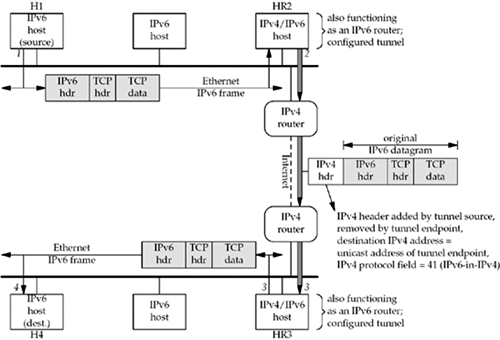B.3 The 6bone
The 6bone is a virtual network that was created
in 1996 for reasons similar to the MBone: users with islands of
IPv6-capable hosts wanted to connect them together using a virtual
network without waiting for all the intermediate routers to become
IPv6-capable. As of this writing, it is being phased out in favor
of native IPv6 deployment; it is expected that the 6bone will cease
to operate by June 2006 [Fink and Hinden 2003]. We cover the 6bone
here because the examples still demonstrate configured tunnels. We
will expand the example to include dynamic tunnels in Section B.4.
Figure
B.2 shows an example of two IPv6-capable LANs connected with a
tunnel across IPv4-only routers. We show the following numbered
steps in this figure:

-
Host H1 on the
top LAN sends an IPv6 datagram containing a TCP segment to host H4
on the bottom LAN. We designate these two hosts as "IPv6 hosts,"
but both probably run IPv4 also. The IPv6 routing table on H1
specifies that host HR2 is the next-hop router and an IPv6 datagram
is sent to this host.
-
Host
HR2 has a configured tunnel to host HR3. This configured tunnel
allows IPv6 datagrams to be sent between the two tunnel endpoints
across an IPv4 Internet by encapsulating the IPv6 datagram in an
IPv4 datagram (called "IPv6-in-IPv4 encapsulation"). The IPv4
protocol field has a value of 41. We note that the two IPv4/IPv6
hosts at the ends of the tunnel, HR2 and HR3, are both acting as
IPv6 routers since they are forwarding IPv6 datagrams that they
receive on one interface out another interface. The configured
tunnel counts as an interface, even though it is a virtual
interface and not a physical interface.
-
The
tunnel endpoint, HR3, receives the encapsulated datagram, strips
off the IPv4 header, and sends the IPv6 datagram onto its
LAN.
-
The
destination, H4, receives the IPv6 datagram.

|